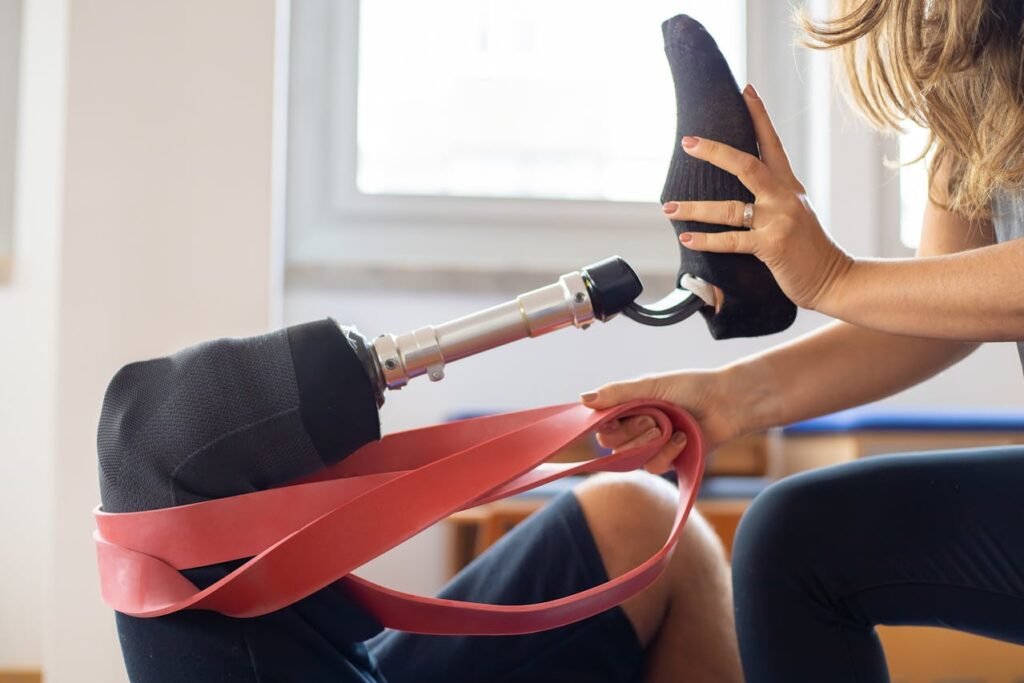After an amputation, the body begins a journey of healing and change. One of the most important parts of this journey is getting ready to use a prosthetic. But before standing or walking with a prosthetic becomes possible, the residual limb must be properly shaped, protected, and prepared. This is where compression therapy plays a key role.
At Robobionics, we help people prepare for prosthetic use every day. We’ve seen how compression therapy helps reduce swelling, shape the limb, and support faster healing. It’s not just a routine step—it’s a foundation for a smoother, safer, and more comfortable experience when you begin using a prosthesis. In this guide, we’ll walk you through what compression therapy is, how it works, and why it matters so much in early prosthetic care.
Understanding What Compression Therapy Really Means
Compression therapy is a simple but powerful technique used after amputation to help the limb heal and get ready for prosthetic fitting. It involves applying gentle, even pressure to the residual limb using special materials like elastic bandages, shrinker socks, or silicone liners.
Why Compression Matters After Amputation
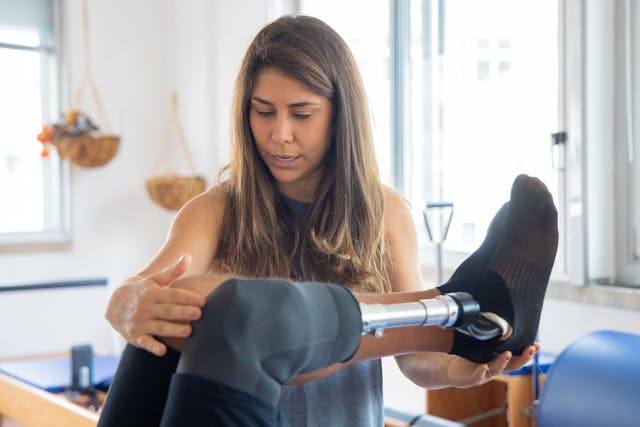
Right after surgery, the residual limb is swollen, soft, and sensitive. The body naturally responds to surgery by sending fluids to the area, but this swelling can make it hard to fit a prosthetic. If swelling stays for too long, the limb becomes misshapen or harder to manage later.
Compression therapy helps by applying controlled pressure to reduce this swelling. It guides the fluid away from the limb and helps the tissues settle into a round, even shape. This makes future prosthetic fittings easier, more comfortable, and more accurate.
At Robobionics, we start compression therapy early under medical guidance. It helps users feel better and get back on their feet with confidence when the time is right.
The Different Forms of Compression Used
Compression can be done in several ways. The most common methods include soft elastic bandaging and shrinker socks. These are easy to use and can be adjusted as the limb changes. For more advanced needs, silicone liners or semi-rigid dressing systems are used, especially when preparing for early prosthetic fitting.
Each method has the same goal—to control swelling, protect the skin, and support healing. The choice depends on the condition of the limb, how fast it’s healing, and how close the user is to being fitted for a prosthetic.
Robobionics uses a mix of modern and traditional compression tools. We guide each user based on their stage of healing and make sure the technique is easy to manage at home.
When to Start Compression Therapy
Compression therapy usually begins once the surgical site is closed and stable. Doctors and prosthetists work together to decide the right time. If there are stitches, they must be fully healed. If there is any sign of infection, compression is delayed until the risk is gone.
In most cases, compression begins a few days or weeks after surgery. Starting too early can interfere with healing. Starting too late can make prosthetic fitting harder. The goal is to begin gently and increase use as the body allows.
At Robobionics, we watch for the right signs before starting. We provide users and caregivers with easy instructions and daily schedules so that compression becomes a smooth part of recovery.
How Compression Therapy Shapes the Residual Limb
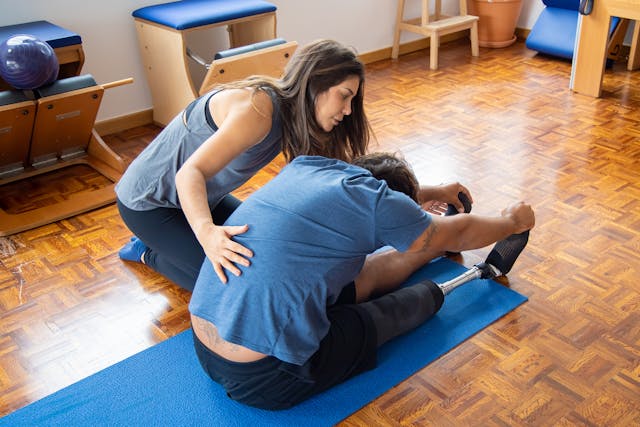
One of the most important reasons for using compression therapy is to shape the residual limb correctly. A well-shaped limb fits better into a prosthetic socket and allows for better balance, comfort, and control.
Shaping Helps the Socket Fit Better
A good socket fit is the foundation of successful prosthetic use. If the limb is uneven or swollen, the socket will not fit properly. It may cause pressure points, pain, or movement problems. Compression therapy creates a smooth, rounded limb that fits snugly inside the socket without gaps or strain.
This shape also helps with suspension, which is how the prosthetic stays on the limb. A limb that is too soft or misshaped may not hold the prosthetic well. This can cause slippage or discomfort while walking.
At Robobionics, we monitor limb shape closely using 3D scans. This allows us to adjust compression methods in real time and prepare the best socket design when the time comes.
Encouraging Even Healing of Tissues
After surgery, the tissues in the residual limb heal at different rates. Some areas may become hard while others stay soft. Without compression, these differences can lead to bumpy or irregular shapes. This makes socket fitting more complex and can delay the fitting timeline.
Compression therapy evens out the healing by applying gentle pressure across the entire surface. This supports uniform tissue growth and reduces fluid buildup. It also helps with skin care by keeping the limb protected and covered from outside irritation.
Robobionics users often see faster improvement in shape and firmness with regular compression use. We also teach safe massage techniques to help with soft tissue movement and comfort.
Helping the Limb Adjust to Pressure
Wearing a prosthetic means the limb will be under pressure every day. If the limb is not used to this pressure, the skin may break down or become irritated. Compression therapy helps prepare the skin and tissues to handle this pressure gradually.
By applying compression daily, the limb becomes stronger and more tolerant. This reduces the risk of blisters, redness, or pain when the prosthetic is finally worn for longer hours. It also gives users confidence that their limb can handle the demands of walking and standing.
At Robobionics, we treat compression therapy as a stepping stone—not just to shape the limb, but to prepare it for real-life use. Our approach helps users feel secure before their first fitting even begins.
How Compression Therapy Supports Early Mobility
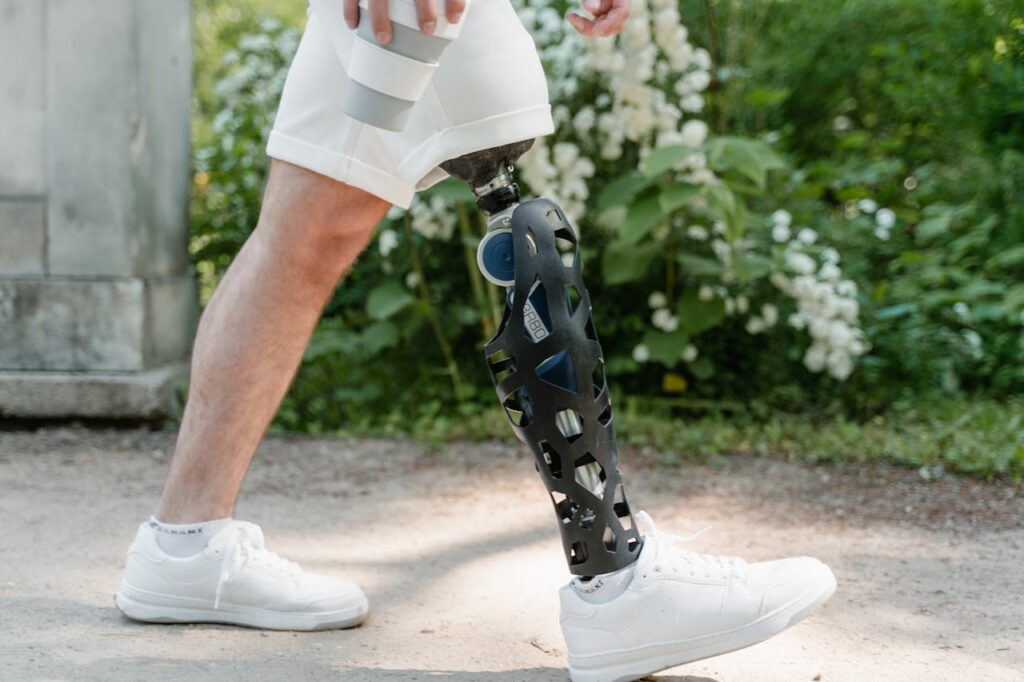
One of the goals of early prosthetic fitting is to help users regain movement as soon as it’s safe. But without a well-prepared limb, early mobility can feel uncomfortable or risky. Compression therapy builds the foundation that makes standing, balancing, and walking easier during the early stages of prosthetic use.
Making Weight-Bearing More Comfortable
When you first start putting weight on your residual limb with a prosthetic, even small steps can feel strange. If your limb is swollen, soft, or uneven, the pressure can lead to discomfort. This can discourage movement or make you rely more on assistive devices longer than needed.
Compression therapy firms up the limb and reduces excess fluid. This means when it’s time to bear weight, the pressure feels more even and stable. The limb can support the body better without shifting or sinking into the socket. This improves posture and reduces the chances of strain or imbalance.
At Robobionics, we often begin compression therapy alongside gentle weight-bearing routines. This combination helps users take their first supported steps with more ease and less fear.
Improving Balance and Stability in Early Steps
Balance is one of the biggest challenges after amputation. When your body changes, so does your center of gravity. Early compression therapy helps by shaping the limb to fit properly in the prosthetic socket, which gives you better control during standing and walking.
A well-shaped limb allows the socket to stay firmly in place without movement. This stability builds trust between your limb and the prosthetic. When the prosthetic moves as expected, your body begins to relearn balance, making early mobility smoother and safer.
Robobionics supports users during these early steps with real-time feedback, therapist guidance, and device adjustments to make every moment of movement feel secure.
Giving You the Confidence to Start Moving
Even with the best prosthetic, starting to move again is just as much about the mind as it is about the body. If your limb feels sensitive or unprepared, you may hold back from taking your first step. But when you know your limb is strong, shaped, and supported, that confidence changes everything.
Compression therapy helps reduce that hesitation. It gives you the feeling that your limb is protected and ready. It reminds you that progress is possible and that your body can adapt. This mental shift can be the difference between waiting and walking.
At Robobionics, we believe that early success begins with preparation. That’s why we encourage every user to start compression therapy early—so that when the time comes to move, they’re truly ready inside and out.
Why Compression Therapy Leads to Better Prosthetic Fitting
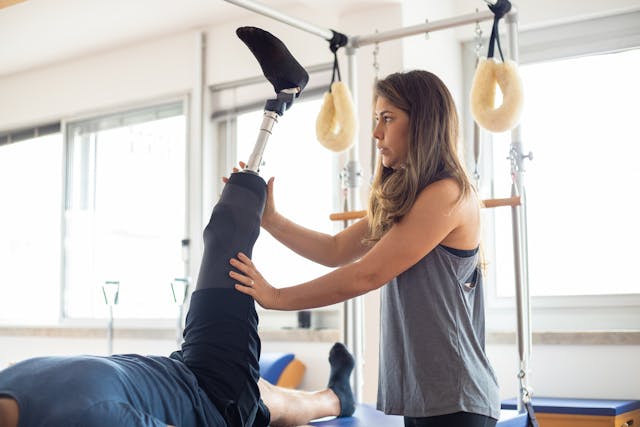
One of the biggest advantages of using compression therapy during recovery is that it helps you get a better fit when it’s time for your custom prosthetic. The shape and condition of your limb affect how well the socket fits, how comfortable it feels, and how efficiently it works.
Achieving the Right Socket Fit on the First Try
When the residual limb is shaped properly through compression therapy, the first socket made by your prosthetist is more likely to fit well. This reduces the number of adjustments needed and speeds up the process of getting a stable, working prosthetic.
If the limb is uneven or still swollen, it can be difficult to get the socket to stay in place. This can lead to more appointments, more discomfort, and a longer wait before you can walk confidently. Proper compression early on prevents this delay by giving your prosthetist a clear and stable shape to work with.
At Robobionics, we use limb scanning and shape monitoring during the compression phase. This allows us to design a socket that fits just right—saving time and reducing stress.
Reducing the Risk of Pain and Pressure Points
When a prosthetic doesn’t fit well, certain areas of the limb may carry more weight than others. This can create hot spots, pain, and even skin breakdown. But when compression therapy is used to shape the limb evenly, pressure is distributed more naturally inside the socket.
This balanced pressure improves comfort during walking and reduces the need for extra padding or frequent refitting. It also helps users wear their prosthetic for longer periods each day without irritation.
Robobionics designs each socket with a focus on comfort and pressure relief—but the best results always begin with a limb that’s been properly shaped and strengthened through compression.
Supporting Long-Term Fit and Function
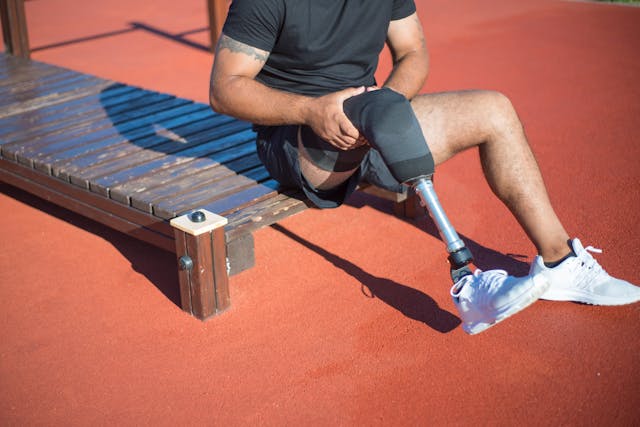
Even after you receive your final prosthetic, your limb will continue to change slightly over time. A limb that’s been well-prepared with compression therapy is more stable, more resilient, and less likely to shrink or swell unexpectedly.
This leads to a longer-lasting socket fit and fewer changes needed in the first year of prosthetic use. It also allows you to focus more on therapy, daily activities, and movement—rather than worrying about comfort or adjustments.
At Robobionics, we believe in building not just a device—but a long-term solution. Compression therapy is a key part of that solution, helping you get the most out of your prosthetic and your recovery journey.
Building a Daily Compression Therapy Routine
Consistency is key when it comes to compression therapy. It’s not something that helps only once or twice. The real benefit comes from making it part of your daily life. With a little time and practice, it becomes a natural step in your recovery, like brushing your teeth or stretching in the morning.
How to Make Compression a Simple Daily Habit
In the beginning, compression may feel unfamiliar. You may need help wrapping the limb or remembering when to wear your shrinker sock. But over time, these actions become second nature. The easiest way to stay on track is by creating a routine. For example, putting on your shrinker sock after your morning bath and taking it off before bed.
You’ll also need to check the skin each day. If you notice redness, dry patches, or any open areas, give your prosthetist a call. These signs don’t mean you need to stop, but they may mean the compression needs adjusting.
At Robobionics, we give every user a simple care calendar to follow. It includes reminders for wear time, skin checks, and when to switch to a smaller size if your limb shape is changing fast.
Staying Motivated Through Progress
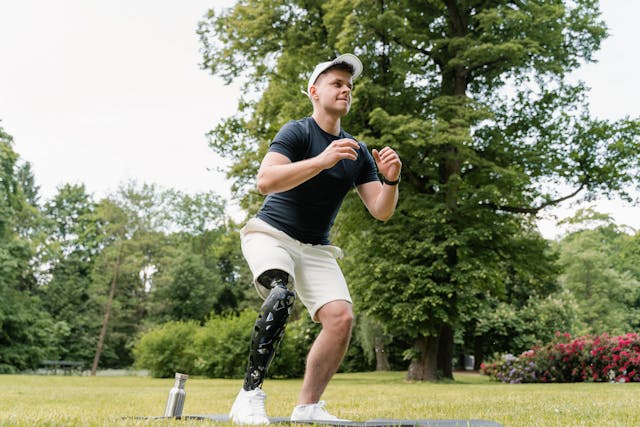
Some people feel frustrated when results don’t appear overnight. But with compression therapy, the progress is often happening in small ways you can’t see right away. Each day you wear the sock or use the wrap, you’re reducing swelling, shaping the limb, and helping your body prepare for walking.
Take a photo of your limb every few days or ask your prosthetist to show you the measurements. Watching the numbers go down or seeing the shape improve can be a big motivator. Knowing your actions are making a real difference helps you stay consistent.
Robobionics encourages all users to track progress in small ways. Every tiny change matters. We celebrate these moments with you—because they lead to bigger milestones ahead.
Involving Your Family or Caregivers
Compression therapy doesn’t have to be done alone. If you have a family member or caregiver, involve them in the process. Teach them how to help you wrap your limb, check the skin, or adjust the sock. Having someone by your side not only makes the task easier but also reminds you that you’re not on this journey alone.
At Robobionics, we include caregivers in our training sessions. We show them how to help safely and give them tips for offering support without pressure. Healing is always easier with a team.
Conclusion
Compression therapy might seem like a small part of your recovery, but its impact is huge. It prepares your limb for prosthetic use, protects your skin, supports healing, and gives you a head start on movement. When done consistently, it shapes not just your body—but your confidence, strength, and readiness for the next stage of life.
At Robobionics, we believe that every step of your recovery matters. That’s why we guide you from day one—helping you build strong habits, giving you the right tools, and standing by your side as you prepare for your first fitting. Compression therapy is the first step toward walking, moving, and living fully again.
If you’re getting ready for a prosthetic or want to learn how compression therapy fits into your recovery plan, contact Robobionics today.



